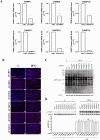PARP14 is regulated by the PARP9/DTX3L complex and promotes interferon γ-induced ADP-ribosylation
- PMID: 38834852
- PMCID: PMC11251048
- DOI: 10.1038/s44318-024-00125-1
PARP14 is regulated by the PARP9/DTX3L complex and promotes interferon γ-induced ADP-ribosylation
Abstract
Protein ADP-ribosylation plays important but ill-defined roles in antiviral signalling cascades such as the interferon response. Several viruses of clinical interest, including coronaviruses, express hydrolases that reverse ADP-ribosylation catalysed by host enzymes, suggesting an important role for this modification in host-pathogen interactions. However, which ADP-ribosyltransferases mediate host ADP-ribosylation, what proteins and pathways they target and how these modifications affect viral infection and pathogenesis is currently unclear. Here we show that host ADP-ribosyltransferase activity induced by IFNγ signalling depends on PARP14 catalytic activity and that the PARP9/DTX3L complex is required to uphold PARP14 protein levels via post-translational mechanisms. Both the PARP9/DTX3L complex and PARP14 localise to IFNγ-induced cytoplasmic inclusions containing ADP-ribosylated proteins, and both PARP14 itself and DTX3L are likely targets of PARP14 ADP-ribosylation. We provide evidence that these modifications are hydrolysed by the SARS-CoV-2 Nsp3 macrodomain, shedding light on the intricate cross-regulation between IFN-induced ADP-ribosyltransferases and the potential roles of the coronavirus macrodomain in counteracting their activity.
Keywords: ADP-Ribosylation; Coronavirus; Innate Immunity; Interferon; PARP.
© 2024. The Author(s).
Conflict of interest statement
The authors declare no competing interests.
Figures










Similar articles
-
The SARS-CoV-2 Nsp3 macrodomain reverses PARP9/DTX3L-dependent ADP-ribosylation induced by interferon signaling.J Biol Chem. 2021 Sep;297(3):101041. doi: 10.1016/j.jbc.2021.101041. Epub 2021 Aug 4. J Biol Chem. 2021. PMID: 34358560 Free PMC article.
-
PARP14 and PARP9/DTX3L regulate interferon-induced ADP-ribosylation.EMBO J. 2024 Jul;43(14):2929-2953. doi: 10.1038/s44318-024-00126-0. Epub 2024 Jun 4. EMBO J. 2024. PMID: 38834853 Free PMC article.
-
KH-like Domains in PARP9/DTX3L and PARP14 Coordinate Protein-Protein Interactions to Promote Cancer Cell Survival.J Mol Biol. 2024 Feb 15;436(4):168434. doi: 10.1016/j.jmb.2023.168434. Epub 2024 Jan 3. J Mol Biol. 2024. PMID: 38182103 Free PMC article.
-
Host ADP-ribosylation and the SARS-CoV-2 macrodomain.Biochem Soc Trans. 2021 Aug 27;49(4):1711-1721. doi: 10.1042/BST20201212. Biochem Soc Trans. 2021. PMID: 34351418 Free PMC article. Review.
-
PARP7 as a new target for activating anti-tumor immunity in cancer.EMBO Mol Med. 2025 May;17(5):872-888. doi: 10.1038/s44321-025-00214-6. Epub 2025 Mar 24. EMBO Mol Med. 2025. PMID: 40128585 Free PMC article. Review.
Cited by
-
Interferon-induced PARP14-mediated ADP-ribosylation in p62 bodies requires the ubiquitin-proteasome system.EMBO J. 2025 May;44(10):2741-2773. doi: 10.1038/s44318-025-00421-4. Epub 2025 Apr 7. EMBO J. 2025. PMID: 40195501 Free PMC article.
-
PARP14 is an interferon (IFN)-induced host factor that promotes IFN production and affects the replication of multiple viruses.bioRxiv [Preprint]. 2025 Apr 16:2024.04.26.591186. doi: 10.1101/2024.04.26.591186. bioRxiv. 2025. PMID: 38712082 Free PMC article. Preprint.
-
Mutation of a highly conserved isoleucine residue in loop 2 of several β-coronavirus macrodomains indicates that enhanced ADP-ribose binding is detrimental to infection.bioRxiv [Preprint]. 2024 Jul 12:2024.01.03.574082. doi: 10.1101/2024.01.03.574082. bioRxiv. 2024. Update in: J Virol. 2024 Nov 19;98(11):e0131324. doi: 10.1128/jvi.01313-24. PMID: 38260573 Free PMC article. Updated. Preprint.
-
Ubiquitin is directly linked via an ester to protein-conjugated mono-ADP-ribose.EMBO J. 2025 Apr;44(8):2211-2231. doi: 10.1038/s44318-025-00391-7. Epub 2025 Feb 25. EMBO J. 2025. PMID: 40000907 Free PMC article.
-
Mutation of a highly conserved isoleucine residue in loop 2 of several β-coronavirus macrodomains indicates that enhanced ADP-ribose binding is detrimental for replication.J Virol. 2024 Nov 19;98(11):e0131324. doi: 10.1128/jvi.01313-24. Epub 2024 Oct 10. J Virol. 2024. PMID: 39387584 Free PMC article.
References
-
- Abraham R, Hauer D, McPherson RL, Utt A, Kirby IT, Cohen MS, Merits A, Leung AKL, Griffin DE. ADP-ribosyl-binding and hydrolase activities of the alphavirus nsP3 macrodomain are critical for initiation of virus replication. Proc Natl Acad Sci USA. 2018;115:E10457–E10466. doi: 10.1073/pnas.1812130115. - DOI - PMC - PubMed
MeSH terms
Substances
Grants and funding
- 2018/18007-5/Fundação de Amparo à Pesquisa do Estado de São Paulo (FAPESP)
- 2020/05317-6/Fundação de Amparo à Pesquisa do Estado de São Paulo (FAPESP)
- 2019/25914-1/Fundação de Amparo à Pesquisa do Estado de São Paulo (FAPESP)
- 2020/11162-5 and 2022/10947-4/Fundação de Amparo à Pesquisa do Estado de São Paulo (FAPESP)
- 2019/06039-2/Fundação de Amparo à Pesquisa do Estado de São Paulo (FAPESP)
LinkOut - more resources
Full Text Sources
Miscellaneous

